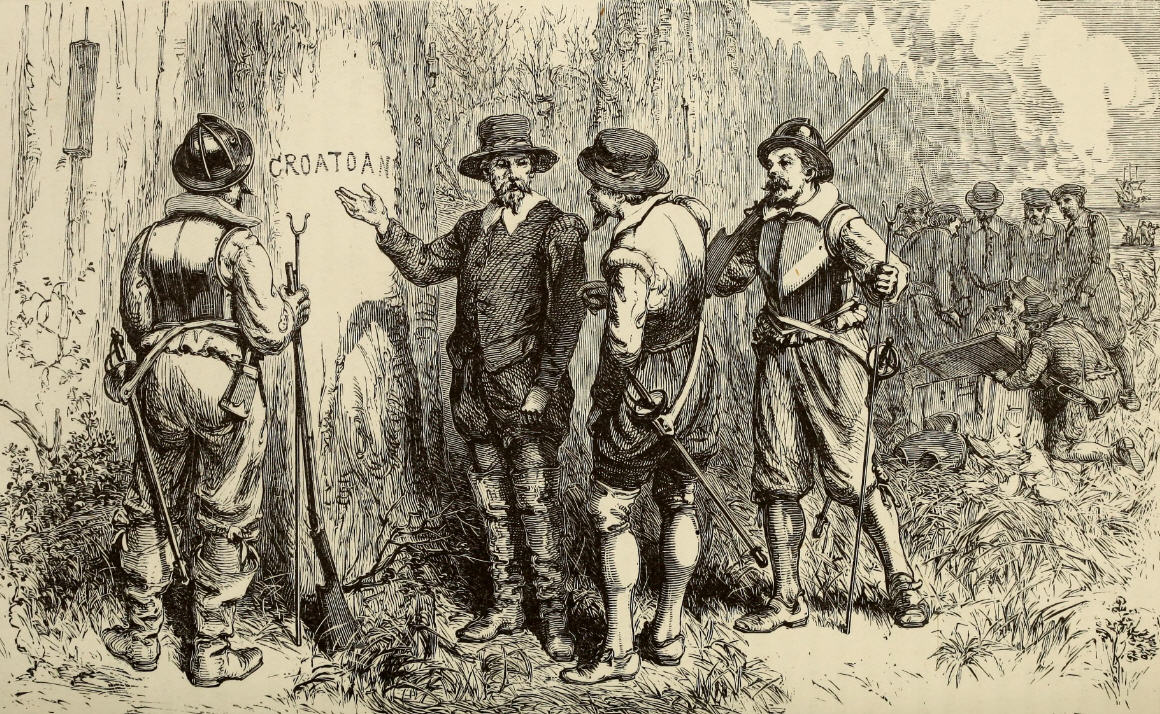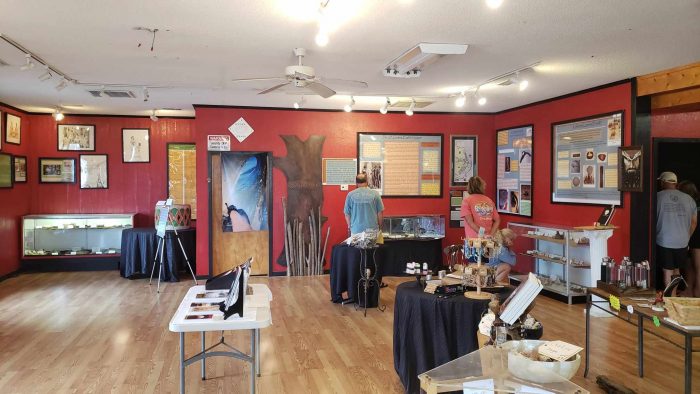
“It’s not a mystery. It has never been a mystery.”
Hatteras Island native Scott Dawson is on a mission to debunk a globally accepted version of history that has been perpetuated for nearly 100 years.
In 1587, roughly 115 men, women, and children, led by Captain John White, arrived on Roanoke Island with the goal of creating America’s first English colony. White left the colony soon after it was established, and when he returned in 1590, the entire settlement had disappeared, including homes, personal belongings, and every single member of the original English inhabitants. There was no trace of what happened, apart from a single mysterious and unknown word – “Croatoan” – carved into a wooden post. This led to the infamy of The Lost Colony, and a generations-old mystery that remains unsolved to this day.
Except that it’s not.

“The misinformation is widespread and deep,” said Dawson. “The myth is so old, and has been repeated long enough, that people think it’s real. That’s why it’s important to go back to the primary sources.”
Dawson is fighting an uphill battle when it comes to unveiling the personal accounts and the science that contradict the existence of an actual centuries-old mystery.
The unknown fate of the colonists, (and the devious and pearl-clutching endings that this scenario suggests), still reverberates in television specials, children’s books, and even textbooks for multiple grade levels.
This supposed mystery was the plot of the original 1937 Lost Colony play (which was likely the origin of the persistent myth), and there are very few voices that are sharing the less exciting version of what actually happened.
“The Lost Colony mystery is a popular story, but that’s all it is. A story,” said Dawson. “Our goal is to change the narrative using science and primary sources to tell the truth about the Croatoan and Hatteras Island… starting by acknowledging their existence.”
So, what really happened? A synopsis of the sources
Dawson provides detailed first-hand accounts and supplemental interpretations in his book “The Lost Colony and Hatteras Island,” but a watered-down version of the broad content goes like this.
There were two English expeditions to Hatteras Island before a colony was sent to Roanoke Island, which occurred in 1584 and 1585. The primary goal of these expeditions was to raid Spanish ships, as Spain and England were in the beginning stages of the Anglo-Spanish War (1585–1604), but planting down roots in America was a secondary yet still important goal of these expeditions.
1584
When Captain Phillip Amadas and Captain Arthur Barlowe arrived on Hatteras Island in 1584, (or possibly Ocracoke Island), it sparked the first-ever meeting between the English and the Native Americans, as three members of the local Croatoan approached the vessels by canoe, boarded the ship, and enjoyed wine and meats with the new visitors. In return, the Croatoan members went fishing, and within 30 minutes, had loaded the English visitors’ boats with fresh catches.
Here’s an excerpt from Barlowe’s account of this first encounter:
“And after he had spoken of many things not understood by us, we brought him with his owne good liking, aboord the ships, and gave him a shirt, a hat & some other things, and made him taste of our wine, and our meat, which he liked very wel: and after having viewed both barks, he departed, and went to his owne boate againe, which hee had left in a little Cove or Creeke adjoyning: assoone as hee was two bow shoot into the water, hee fell to fishing, and in lesse then halfe an houre, he has laden his boate as deepe, as it could swimme, with which hee came againe to the point of the lande, and there he devided his fishe into two parts, pointing one part to the ship, and the other to the pinnesse: which, after he had (as much as he might) requited the former benefites receaved, departed out of our sight.”
When Barlowe returned six weeks later, he brought along Manteo – leader of the Croatoan – and Wanchese as ambassadors of sorts, although when paraded throughout England in the court of Elizabeth I and other aristocratic households, they were used as props, and more or less viewed as a sideshow attraction. Nevertheless, the success of this first voyage – and the new friendly relations initiated by the Croatoans – paved the way for the funding of further expeditions.
1585
The second expedition, unfortunately, led to the first stirrings of conflict with the Native Americans, but it wasn’t with the Hatteras Island-based Croatoan. Sir Richard Grenville, (a cousin of Sir Walter Raleigh), led a host of six ships and 600 men, including Manteo and Wanchese on a return trip home, in an initiative to return to Croatoan and attack as many Spanish ships as possible while following the Gulf Stream route from England to the U.S. East Coast.
Unfortunately, another English explorer, Sir Ralph Lane, was also in tow, and when Grenville left the Outer Banks leaving Lane in charge, things started to go south. According to Dawson’s book, the trouble began at a mainland village called Aguscogoc, (near modern-day Scranton), where Lane was meeting with a different tribe, the Secotan.
After their visit, the English noticed that a silver cup was missing. In response to the perceived theft, they burned the Secotan’s village to the ground.
This spurred a years-long conflict that saw the Croatoan joining forces with the English to attack and subdue the Secotan. Despite this new rash of assaults against a neighboring native population, (which never occurred in 1584), the Croatoan – perhaps naively – considered the English friends, and they remained a powerful alley in the skirmishes and attacks against the Secotan that followed.
The 1587 “Lost” Colony
The background of the 1584-1586 journeys is essential because they lay down the foundation of the not-so-mysterious fate of the colonists. At this time, the Croatoan were still English allies, while the Secotan – just inland of Roanoke Island – were most definitely not.
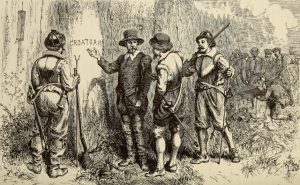
Before the Lost Colony arrived, a group of 15 men who had been purposely left behind on Roanoke Island during a resupply mission were attacked by the Secotan and killed, with their fort burned to the ground. The Lost Colonists were encountering a conflict-infused situation on Roanoke, but the Croatoan on Hatteras Island – just an island or so away – were still loyal friends of the English.
Captain John White, who led the 1587 colonization expedition, even recounted the first meeting with their old friends, which ended up being inches away from destroying relations with the native Hatteras Islanders.
At our first landing, they seemed as though they would fight with us; but, perceiving us to begin to march with our shot towards them, they turned their backs, and fled. Then Manteo their countryman called to them in their own language, whom as soon as they heard, they returned, and threw away their bows and arrows; and some of them came unto us, embracing and entertaining us friendly, desiring us not to gather or spill any of their corn, for they had but little. We answered them that neither their corn, nor any thing of theirs, should be diminished by any of us; and that our coming was only to renew the old love that was between us and them at the first, and to live with them as brethren and friends.
Before leaving behind the colonists in 1587, (which included his own pregnant daughter), John White told them that if anything happened, they should leave behind some sort of sign of where they went, and to add a cross to the marker if their departure was due to dire circumstances.
This turned out to be good guidance, as shortly after the colonists arrived on Roanoke Island, one of the colony’s members, George Howel, was killed by the Secotan who ambushed him while he was alone crabbing. He was shot 16 times with arrows, and had his head bashed in with war clubs.
When the colony found Howel’s body, they sent Manteo and 20 Englishmen to the Croatoan on Hatteras Island to find out who killed him and what happened to the 15 men left behind the year before. The Croatoan hosted the English to a feast and told them it was the Secotan who had killed the 15 men, as well as George Howel. Then, the Croatoan raided a Secotan village and gave all the corn and pumpkins they stole to the English. Clearly, one corner of the Outer Banks was home to friends, and another – Roanoke Island where the Lost Colony was initially stationed – was home to foes.
White wasn’t able to return for three years, mainly due to the now-raging Spanish war, but when he did, his account suggests no fear or confusion about what happened to the colonists, according to Dawson.
Instead, his exact words indicate relief, and a clear understanding of what happened, thanks to the signs left behind, based on his own instructions.
As we entered up the sandy bank, upon a tree, in the very brow thereof, were curiously carved these fair Roman letters, C R 0: which letters presently we knew to signify the place where I should find the planters seated according to a secret token agreed upon between them and me at my last departure from them.
Which was, that in any ways they should not fail to write or carve upon the trees or posts of the doors the name of the place where they should be seated; for at my coming away they were prepared to remove from Roanoke fifty miles into the main.
Therefore at my departure from them in 1587, I willed them, that, if they should happen to be distressed in any of those places, then they should carve over the letters or name a cross +in this form; but we found no such sign of distress.
And, having well considered of this, we passed toward the place where they were left in sundry houses; but we found the houses taken down, and the place very strongly enclosed with a high palisado of great trees, with curtains and flankers, very fort-like. And one of the chief trees or posts at the right side of the entrance had the bark taken off; and five feet from the ground, in fair capital letters, was graven C R O A T O A N, without any cross, or sign of distress.
White tried to get to Hatteras Island to check on the colonists, as did subsequent English explorers, but the Outer Banks’ outlying Graveyard of the Atlantic lived up to its name.
Storms prevented several expeditions from finding the colonists, but the more common deterrent was a general disinterest in locating their whereabouts. As a key example of this phenomenon, Dawson points to the fact that no one from Jamestown, Virginia, (which was settled in 1607), bothered to look for the 1587 settlement, just a couple hundred miles away.
John Lawson and the 100-year gap
The 1587 colonists may have fallen into the black holes of history, rarely to be thought of again, if it wasn’t for explorer John Lawson.
In 1701, Lawson published a book called “A New Voyage to Carolina,” where he distinctly recounts his encounter with the Hatteras Island residents.
These [Hatteras tribe members] tell us, that several of their Ancestors were white People, and could talk in a Book, as we do; the Truth of which is confirm’d by gray Eyes being found frequently amongst these Indians, and no others. They value themselves extremely for their Affinity to the English, and are ready to do them all friendly Offices. It is probable, that this Settlement miscarry’d for want of timely Supplies from England; or thro’ the Treachery of the Natives, for we may reasonably suppose that the English were forced to cohabit with them, for Relief and Conversation; and that in process of Time, they conform’d themselves to the Manners of their Indian Relations. And thus we see, how apt Humane Nature is to degenerate.
Now, it should be noted that the hundred-year gap between White and Lawson presents a bit of a problem. There’s no concrete way to tell if these blue-eyed Hatteras Islanders were descended directly from the “Lost” Colony, or another European source of colonists or shipwrecked individuals, or something in between.
But the first-person accounts from multiple stakeholders who were actually there – John White, Ralph Lane, Richard Grenville, and Arthur Barlowe – should be enough to dispel any mystery of where the “Lost” Colonists were headed when they left Roanoke Island.
“You can argue after [they left] whatever you want – they split up, they tried to sail home, they were eaten by mosquitos, etc.,” said Dawson. “But they’re definitely more the ‘Abandoned Colony of Croatoan’ than the ‘Lost Colony of Roanoke.’”
There’s a second source that evaporates the mystery as well – which Dawson and a team of experts found close to home.
A decade of archeology and discovery, all on display
The new-in-2023 Lost Colony Museum and Gift Shop is a pulpit of sorts for Dawson, who gets to relay the real history to curious visitors, one at a time.
But it’s the centuries of artifacts that are housed in tricky-to-finance display cases within this Buxton Museum that augment the book’s revelations, and bring evidence to light.
“We get from 30 to 200 people a day, and well over half were taught, and had believed, Croatoan was some mystery clue,” said Dawson. “They know none of the real history, but are open to it and [are] interested.”
Dawson started conducting simple archaeological digs in 2009, based on information from family members that was passed down through nine generations.
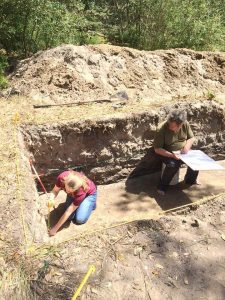
When Dr. Mark Chatwin Horton took notice, a famous British maritime and historical archaeologist, the archeological digs quietly became worldwide news among historians, with dozens of global experts joining in the 1-2 Hatteras Island-based excavations per year.
Concentrating on a Buxton site that’s no larger than a public bathroom at a local beach access, Dawson, Horton, and an ever-rotating team have uncovered artifact after artifact that lends weight to the “Lost” Colonists’ relocation, and subsequent happy integration with island life.
“As an archaeologist, I hate the idea of smoking gun,” said Horton. “Because, in most cases, you really can’t point to a specific artifact and say, ‘This is it – This is the smoking gun.’
“Instead, it’s the quantity of material, and what’s most remarkable here is the number of artifacts we have from this time [period.] That is what is so revealing, really… It’s common sense. It’s not exactly rocket science.”
Horton, who lives in a home in Gloucester, England, that is outfitted with historical fixtures – including the original windows from Sir Francis Drake’s former residence – has appeared with Dawson in a Science Channel documentary, “Lost Colony of Roanoke: New Evidence,” which is currently available to stream on HBO Max.
He has also been a key driving force behind many of the archeological digs on Hatteras Island in the past decade. Dr. Horton initially came to the States in 2007 for a conference on Jamestown, but after hearing about Dawson and his book, his attention was diverted to Hatteras Island. “Without Scott, we could have never done this research,” he said.
During a series of archaeological digs, the intricate process of finding and dating material became essential to bolster an existing theory. In the layers of earth that indicate the late 1500s and early 1600s, the treasure hunters discovered hundreds of artifacts that pointed to a deep connection between the English and the Croatoan.
There were expensive glass plates that were whittled into arrowheads, and pieces of barrel hoops – not a native island substance – that were fashioned into tools. Remnants of longhouses and shell-crafted farming equipment lay side-by-side with glass Venetian beads, in a mess of material that’s still being filtered through today.
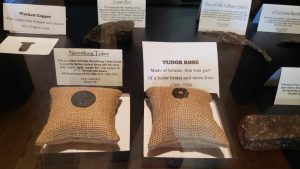
But it’s two items that were uncovered in particular, among the thousands of artifacts, that garnered the most attention. One was a small and smelted bronze Tudor rose, which likely came from a horse bridle, and the other was a Nuremburg token, a casting counter that looks like a coin and was used, (in many instances), on 16th-century ships to count inventory.
“I think the Tudor Rose and Nuremberg token are probably the two most concrete pieces of evidence, but there are also glass arrowheads and [a number] of repurposed items,” said Dawson, noting that once the English visitors were in their new home, a decorative glass plate might not be useful, but a handful or arrowheads carved out of that original and expensive material would be valued.
“The thing about the Nuremberg token is there are three of them that they found on Roanoke Island when they were building the [now Fort Raleigh],” said Dawson. “Two of these tokens have been found on Hatteras Island, and three have been found on Roanoke, and they’re all identical. That can’t be ignored.”
It should be noted that the dates of the artifacts recovered weren’t just gauged by depth, or simple but verifiable hypothesis alone.
At one point, particle physicist and pioneer in XRF technology Bruce Kaiser joined the team, using an X-ray fluorescence (XRF) scanner to determine the exact properties of every piece. “That helped us tremendously, because everything in the world has a unique signature, and you can go through databases and see exactly where [materials] came from,” said Dawson.
As Horton stated, however, it’s the quantity of the evidence that tells the story, and The Lost Colony Museum in Buxton puts all these written and physical sources on full display.
From 900 pages of documents to thousands of artifacts that were unearthed close to home, Dawson hopes the museum’s network of exhibits, videos, and his own interactions will propel Hatteras Island – and its native residences – into a rightful starring role in English colonization and world history.
“I would say a good 65% [of the museum visitors] have no idea about the history, or our digs, or any of it, other than the lost myth,” he said. “What’s funny is almost all of them, upon learning the real story, say something along the lines of ‘You know, when they taught us this as a kid, it never made any sense. What you’re saying makes perfect sense.”
Word of mouth is a limited instrument to wipe out decades of debatable history, especially when the “Lost Colony” story is so prevalent, and is so profitable for media outlets to capitalize on a longstanding mystery. (Who doesn’t tune into a great mystery story, after all?)

There have also been decades of racism that played a role in skewing the real story, with accounts from the early to mid-1900s asserting that the more “intimate” intertwining between the Native Americans and the English never took place – a proposal that first began with Lawson’s 1701 account of the “blue-eyed Indians.”
“There was a strong desire that the first English arrivals did not integrate with the Native Americas,” said Dr. Horton. “It was a much more convenient narrative to get them all killed off… It’s based on stereotypes, and there are still images of colonists being murdered by the natives that have [lingered] to this day.
“We couldn’t have this integration at the time, so historians just ignored clear evidence for generations,” added Dr. Horton.
But according to Dawson and the many experts who have dived deeper into the 1580s era of American history, it’s time for a different story to come to the surface.
“The Croatoan are mentioned throughout the primary sources, and to act like the very word is a total mystery erases them from history,” said Dawson. “Even the very document that contains the birth of Virginia Dare mentions Croatoan as an island three times.
“Unfortunately, fiction has a louder voice than reality, and when they go to war, fiction wins,” said Dawson. “The goal is to change this narrative by telling the truth about the Croatoan tribe… We’ll win this time, because of science. And science doesn’t care about your emotions, or what you’ve heard.”
For more information on The Lost Colony Museum
- The new Lost Colony Museum and Gifts, which is managed by the Croatoan Archaeological Society (CAS), is located at 46618 N.C. Highway 12. Buxton.
- Exhibit display cases are still needed, and the public can help via a GoFundMe campaign, or by donating via the CAS website. Donations are tax-deductible as the CAS is a 501c3 nonprofit organization.
- To keep tabs on the museum’s progress and events, visit the Croatoan Archeological Society’s Facebook page.



